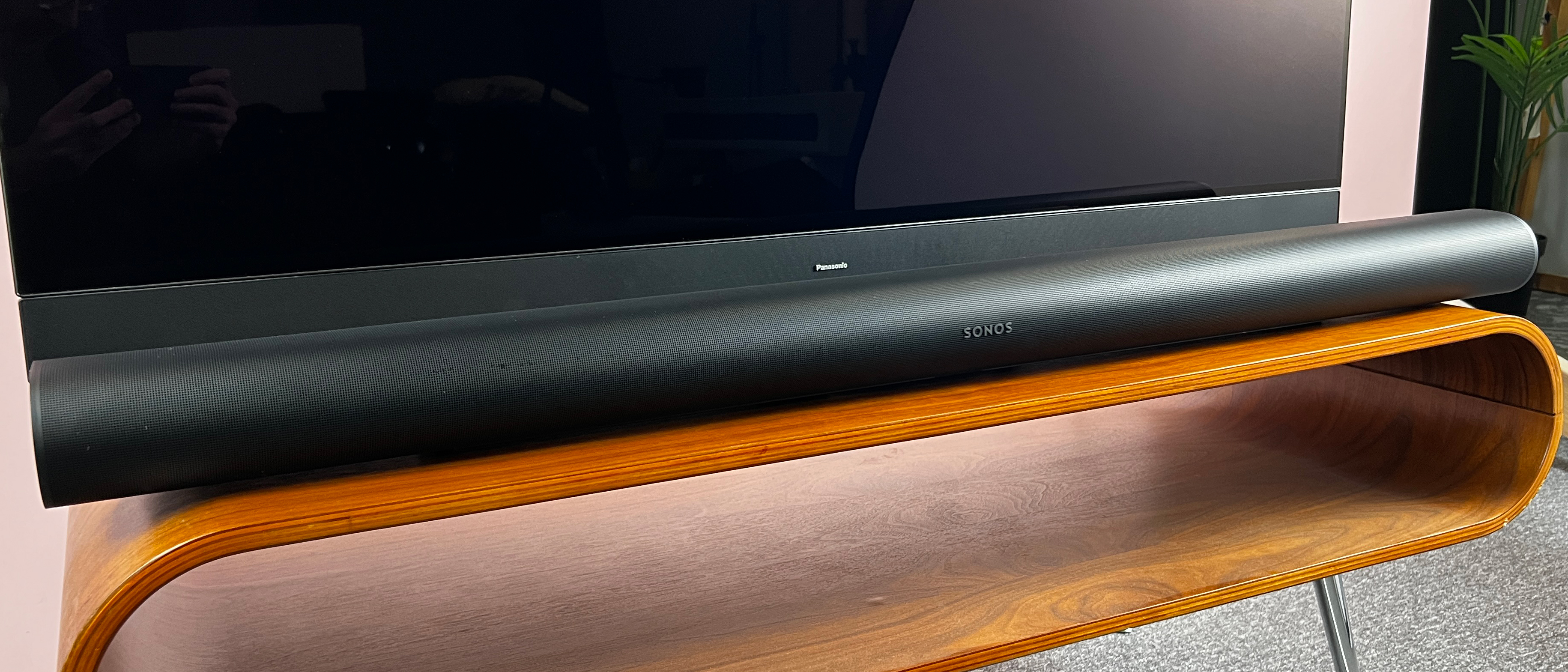TechRadar Verdict
The Sonos Arc Ultra is the best-sounding one-box soundbar you can buy today for the price. It has seriously impressive bass for something so compact; it has superbly balanced sound with clear dialogue that fits naturally into the rest of the movie soundtrack; and it has convincing Dolby Atmos positioning and layering of 3D sound, with great width and excellent height. But it’s frustrating that it doesn’t have HDMI passthrough, and the lack of DTS is a shame.
Pros
- +
Full sound and great speech clarity
- +
Very good Dolby Atmos effects
- +
Compact for such good sound
Cons
- -
No HDMI passthrough ports
- -
No DTS-HD support
- -
Not as immersive as multi-box options
Why you can trust TechRadar
Sonos Arc Ultra review: Two minute review
The Sonos Arc Ultra is the new flagship in Sonos’ soundbar line-up, and it takes everything that was good about the original Arc and cranks it up to the next level. Better Dolby Atmos effects, better bass, better speech clarity, better connectivity.
The Sonos Arc Ultra is a huge step up for music quality over the original Sonos Arc, and while it’s less of a jump up from the original with movies, it’s still a clear and obvious improvement, and ranks among the best soundbars.
Is it worth upgrading from the original Sonos Arc? I think that’ll depend on how much of a cinephile you are; I really appreciated the improved sound balance and the clearer speech, and the obvious improvement to Dolby Atmos effects positioning, and found it hard to go back – but the original Sonos Arc is no slouch, and more casual viewers may find the difference to feel less essential.

The Sonos Arc Ultra keeps the original’s biggest flaw, which is not having any HDMI passthrough port in an era when HDMI ports are becoming a bit of a premium, and effectively all its key rivals offer this. The lack of DTS is also a shame, but won’t be a big problem for most people. I still thoroughly recommend the Sonos Arc Ultra, but it just may not be the best fit for your setup because of its HDMI limitation.
For those wondering about Sonos’ app, I had no problems setting it up, playing with different configurations, and changing settings.
I’m reviewing the Sonos Arc Ultra as a single soundbar here, though I have tested it with the Sub 4 and rear speakers, and I’ll talk about that experience too.
I think the Sonos Arc Ultra gives you the best cinematic experience you can get from a single-unit soundbar for under $1000 / £1000. However, in the UK, you can get the Samsung HW-Q990D for around the same price during sales events, and if you’re happy having a four-box surround system, you’ll get a far more immersive experience. And Sony’s Bravia Theater Bar 9 is a key competitor around the world – it's a single-box soundbar like the Arc Ultra, but it offers the missing HDMI port, and with 4K 120Hz support, no less. It officially costs a lot more than the Sonos Arc Ultra, but sales season discounts bring it down to around the same price. It’s even bigger than the Arc Ultra, though.
Sign up for breaking news, reviews, opinion, top tech deals, and more.
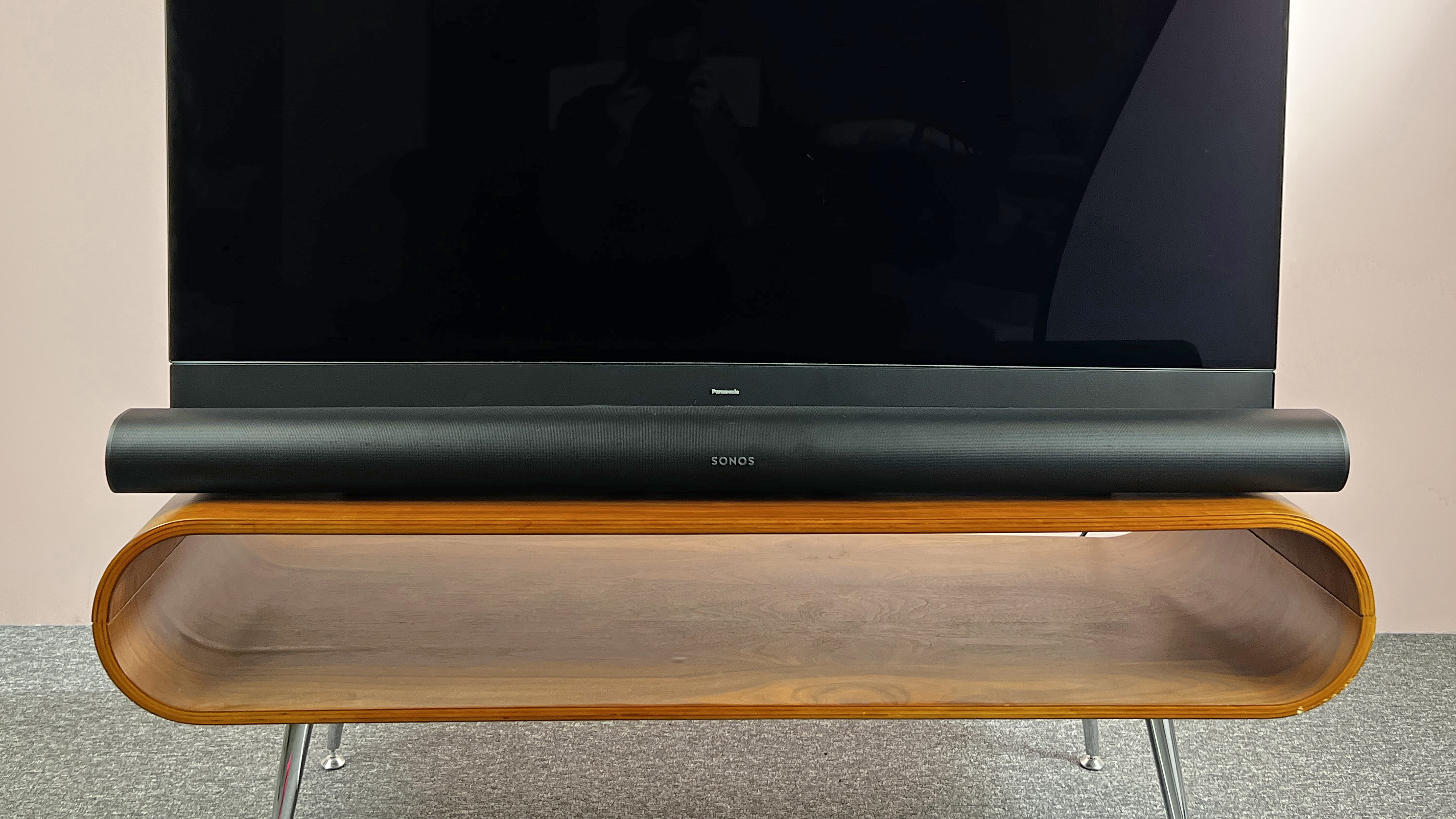
Sonos Arc Ultra review: Price & release date
- Released on October 29, 2024
- Priced at $999 / £999 / AU$1,799
The Sonos Arc Ultra is priced pretty well at $999 / £999 / AU$1,799, considering that other flagship one-box soundbars can be far higher, such as the $2,399 / £1,990 / AU$3,999 Devialet Dione, or the $1,399 / £1,399 / AU$1,795 of the Sony Bravia Theater Bar 9.
Obviously, it's not cheap, and you can find the Samsung HW-Q800D for significantly less, but that's not a one-box soundbar, and building high-quality sound into a single unit that isn't huge (which the Devialet Dione especially is) is hard. For a premium soundbar, the Arc Ultra is competitive.
Sonos Arc Ultra review: Specs
| Dimensions (W x H x D) | 2.95 x 46.38 x 4.35 inches (75 x 1178 x 110.6mm) |
| Speaker channels | 9.1.4 |
| Connections: | 1x HDMI with eARC, Ethernet, Wi-Fi, Bluetooth |
| Dolby Atmos/DTS:X | Yes/No |
| Sub included | No |
| Rear speakers included | No |
| Features | Sonos multi-room, TruePlay tuning, AirPlay 2 |
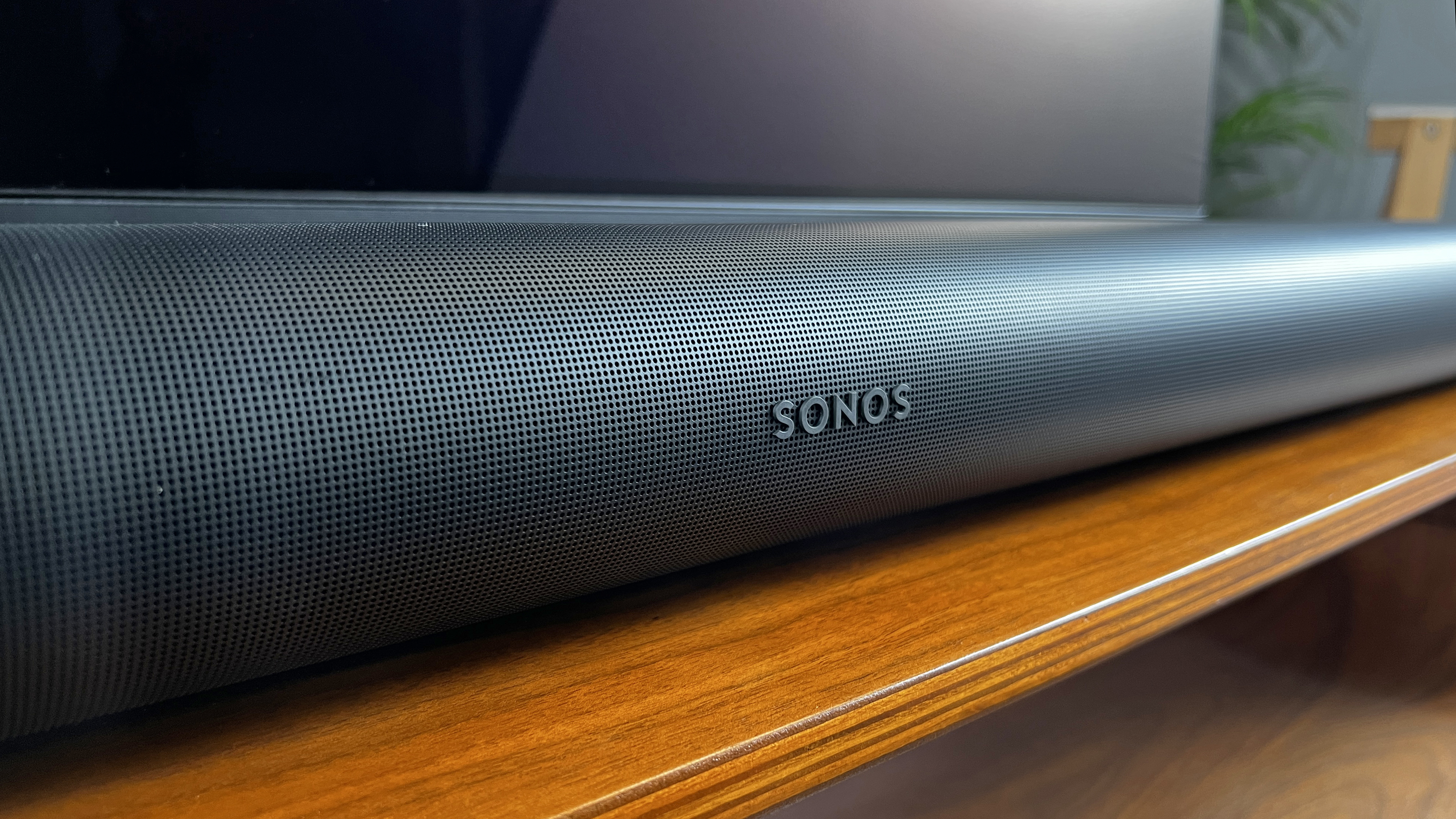
Sonos Arc Ultra review: Features
- 9.1.4 speaker channels, with Sound Motion bass driver
- All Sonos' usual special skills, plus Bluetooth
- Dolby Atmos support, but no DTS
Much like the original Sonos Arc, this is a Dolby Atmos soundbar with HDMI eARC connectivity, Sonos multi-room wireless support, and optional voice control from Alexa or Sonos’ own more limited voice assistant.
The biggest new feature is the Sound Motion driver, which delivers big bass performance from a small speaker, and a generally improved speaker setup that now promises 9.1.4 channels of sound, compared to 5.0.2 from the original Sonos Arc.
There’s also Bluetooth connectivity in the Arc Ultra, which is a first for a Sonos soundbar, but is now standard on the best Sonos speakers at last, including the recent Sonos Era 100 and Sonos Era 300.
Naturally, the Sonos Arc Ultra works with Sonos’ Sub options (including the new Sub 4 as well as older models) and you can connect it to rear speakers for a real surround sound setup. The Arc Ultra is the first Sonos soundbar that doesn’t work with the Sonos Play:1 or Play:5 speakers – but it still works with Sonos One, Sonos Five, the Era models, or with two wired speakers connected to a Sonos Amp.
Sonos’ TruePlay room-tuning tech is here, and it’s finally available on Android in a new ‘quick’ version, which is also available on iOS. This new version will probably be preferable for a lot of people because it’s much easier. It uses the Arc Ultra’s own mic array to test your room using a series of pet-alarming tones, to adjust the system’s sound for better precision and Dolby Atmos surround effects. On iOS, it still asked me to hold my phone where I sit for a set of measurements there first, which is what the full TruePlay system does – but then I didn’t have to walk around the room waving my phone up and down.
The biggest flaw in the Sonos Arc is the lack of any HDMI passthrough ports. Most premium soundbars have more than one HDMI port – one to connect to your TV, and then at least one other that passes video through to your TV, so that you don’t lose the use of one of your HDMI ports for connecting consoles or other video boxes. This is doubly annoying in the majority of TV models available today, which only have two HDMI 2.1 ports for 4K 120Hz support at most, and the HDMI eARC is usually one of those ports, so you’re losing one of the most important ports. (Many LG and Samsung TVs have four HDMI 2.1 ports, so this is less of a problem, and in 2025 far more TVs will have four HDMI 2.1 ports thanks to a new chip from MediaTek – but that doesn’t help TVs today.)
Even ignoring the type of ports, four video devices is not an uncommon amount for people to want to connect to a TV here in 2024, and yet if you have the Sonos Arc Ultra, you can only connect three.
It’s so frustrating, given that it was a complaint I had about the original Sonos Arc when that launched in 2020. I’ve spoken to Sonos about the topic, and the company’s stance has been that HDMI passthrough adds complexity and it wants its soundbars to be as simple as possible. But that only holds true if someone doesn’t then have to deal with the headache of what a good solution is if they want to connect more devices than they have ports free, once the Arc Ultra is connected. I think Sonos has simply off-loaded the complexity to users. With an HDMI passthrough port, I’d have been seriously looking at giving the Arc Ultra a five-star rating overall.
The other notable issue is a lack of DTS decoding. This is not a big problem if your TV or playback device will decode DTS-HD to LPCM, as many will. I had a great time playing DTS-HD Blu-rays while testing the Sonos Arc, and getting the big, powerful, high-quality sound I was expecting. The lack of DTS:X is the more annoying part for purists, especially with it now used on Disney Plus for some movies, but it really isn’t a dealbreaker for the vast majority of people.
The Sonos Arc Ultra works with the audio-swap feature of the Sonos Ace headphones, so you can watch anything that plays on your TV with great spatial audio on the headphones to avoid disturbing others in the house – our Sonos Ace review has more on how well that works, but it’s not affected by the Sonos Arc Ultra's performance, so I won’t go into it here.
- Features score: 4 / 5
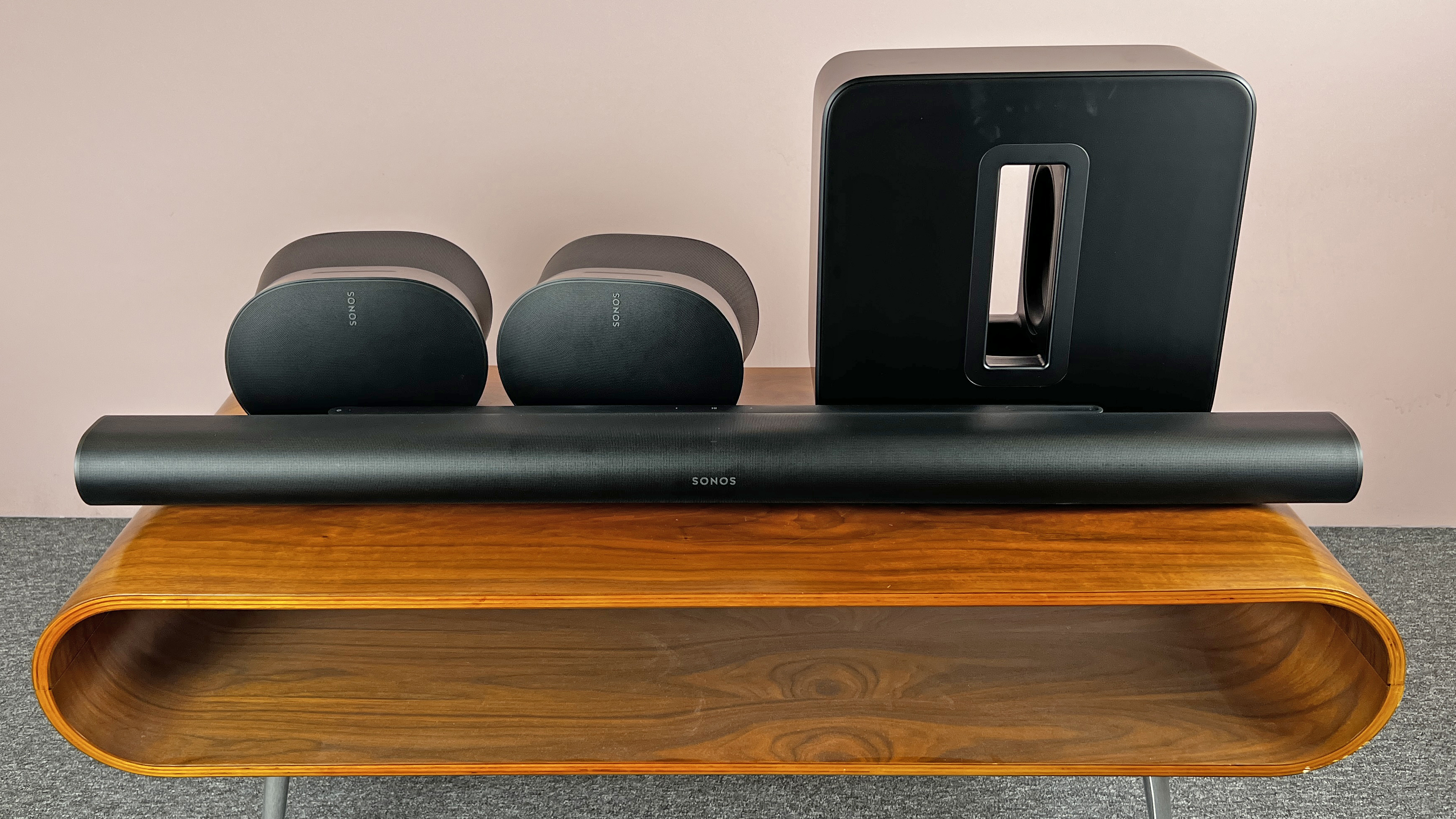
Sonos Arc Ultra review: Performance
- Excellent dynamic range
- Very strong Dolby Atmos effect
- Very clear speech and detail
In my opinion, the Sonos Arc Ultra is the best-sounding single-box soundbar you can get for under $1,000 / £1,000. It delivers fulsome balance and exciting sound with clear speech, and superb height and width. The Devialet Dione maybe does this all better as a single-unit soundbar, but at around twice the price and twice the size, it’s a harder sell in several ways.
Dolby Atmos surround effects don’t seem like they’re coming from behind you, inevitably, but they do feel like they reach you when there are movement effects in particular. Height channels have motion and precision, despite being part virtual – Sonos claims four channels of overhead sound, but there are only two drivers, with the width drivers combining with the height drivers for a sense of four channels, and it works well.
Sound is layered very impressively in Dolby Atmos, with a sense of 3D positioning across the whole space in front of you.
Everything is an improvement over the original Sonos Arc. It’s not quite night and day, but it’s a clear step up anyway. That especially goes for speech clarity and Dolby Atmos effects in movies, with everything feeling just more expansive and more in the room than from the older soundbar.
I tried Sonos’ new and upgraded speech enhancement tools for the Arc Ultra, and they’re very effective, but they affect the sound balance (as do all such tools), and I found that I really didn’t need them anyway on the Arc Ultra. It’s a bit unoriginal to say that the speech in Christopher Nolan movies is hard to hear, but I tested the old and new Arc with them, and there was a big jump in legibility on the Arc Ultra that meant they really weren’t hard to follow any more (generally).
Surprisingly, the new bass driver didn’t create that big an effect compared to the original Sonos Arc in movies that already ramp up the bass, but it does help to make the sound feel fuller in general. It makes the bass that the Arc Ultra can generate better connected through to the mid-range, so the overall balance in low-end-heavy scenes is stronger – and just excellent overall. There’s a good dispersal of the bass so that it doesn’t feel too directional, and the impact is really pleasing for such a relatively compact soundbar.
The Sound Motion bass speaker did really jump out during music though. This actually was a night and day difference from the original Arc, with a massive improvement across the whole frequency range. For music, the original Arc sounded unclear and subdued compared to the Arc Ultra at the same volume. Having said that, I would still put the Arc Ultra essentially on par for music quality with the Sonos Era 300, which is half the price. It’s easier to fill out that sound when you can be thick and tall, unlike a soundbar.
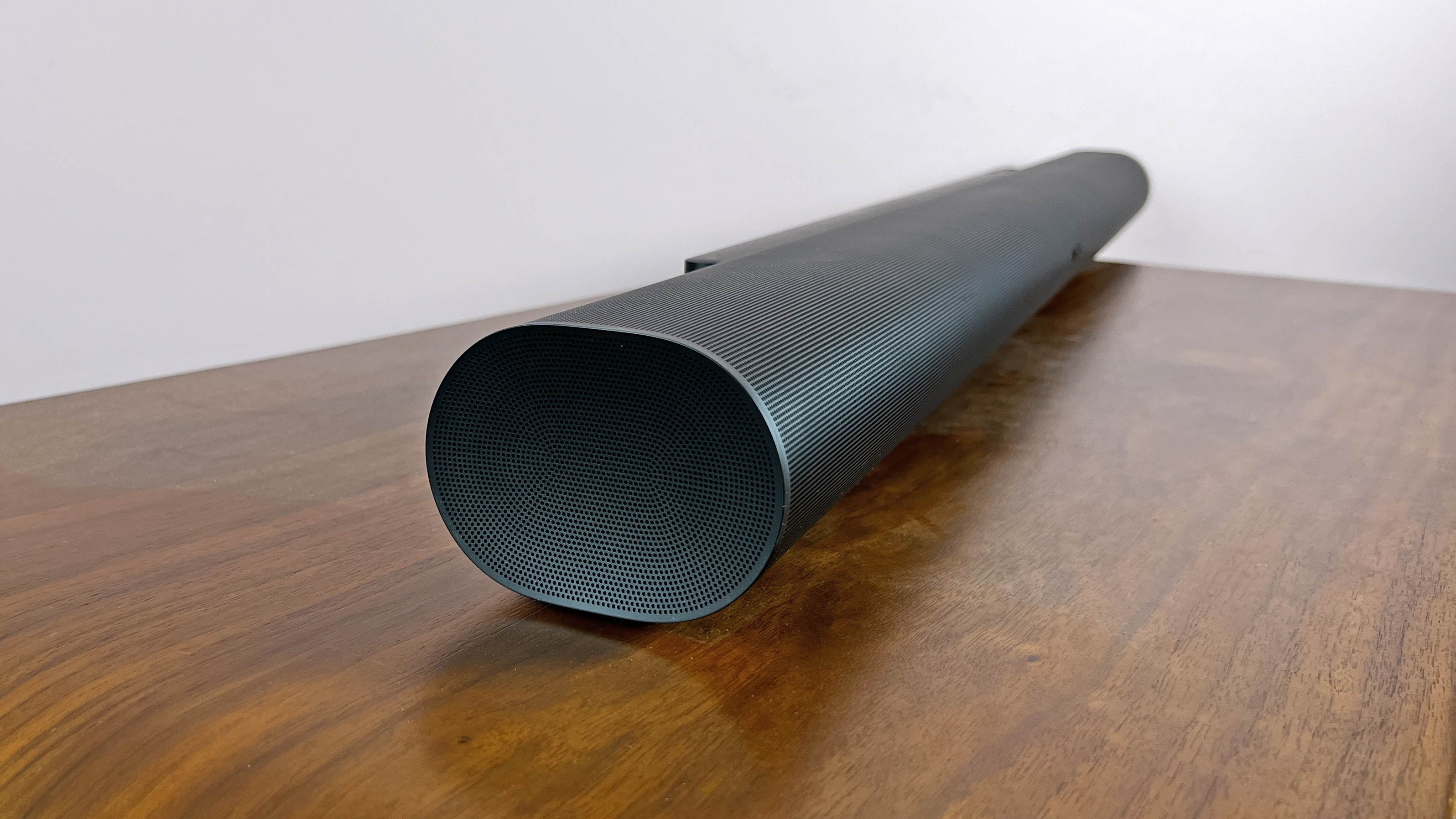
Running TruePlay tuning helps the Dolby Atmos and finer details to come through more clearly, so I absolutely recommend it. There wasn’t a clear difference between the quick version and the full version in my setup, so as I mentioned above, the quick version should be all that most people need to bother with.
To repeat myself from the start of this section, I think the Arc Ultra delivers the best-value cinematic experience from a single-box soundbar. It’s the best combination of a demure design, effective sound reproduction and 3D effects, and a reasonable price given what it can do. More expensive soundbars may do better, but the audio package here is excellent.
I’m reviewing it as a single unit for all the scores here, but I also tested it with a Sub 4 and Era 300 speakers in Sonos’ full-power ultimate system. I also tested it with a Sub 4 only, and then slotted it and the Sub 4 into my existing setup using my Sonos One rear speakers.
Make no mistake – despite the Sound Motion tech being very impressive for bass, the Sub 4 adds a whole new dimension of bass you can feel, in frequencies the soundbar alone simply can’t touch. You will literally get more from your movies with a big sub, though obviously for a premium of $799 / £799.
In the full elite surround mode, with Era 300 units behind as well, you can really feel the overall power of the system. Even with one sub (you can connect a second to more fully spread the bass around) you can feel the power of the low frequencies everywhere, with excellent fullness through to the mid-range, and a clear separation of higher frequencies from that mix. It’s a really well-connected whole system, and testing against the Samsung HW-Q990C, I say you get a more satisfying overall sound profile from the Sonos setup. However, not by that much, considering you’ll pay a lot more for the Sonos system – it kind of proves why Samsung’s top-end soundbars are five-star products among the best Dolby Atmos soundbars. Still, for those with the ear, I think the Sonos system’s sound is superior.
Even with my Sonos Ones as rear speakers, I felt like I was getting a different sound profile from the rears (post TruePlay) than with my Sonos Arc and Sub Mini that I usually have. They felt punchier and with a little more bass added to them, perhaps to match the broader sound profile the bar is capable of compared to the original Arc. I feel that swapping the Arc for the Arc Ultra in my setup would be an upgrade, albeit one that I would enjoy as someone who’s obsessive over sound and setups – perhaps someone more casual about home theater wouldn’t find it to be as good value.
- Performance score: 5 / 5
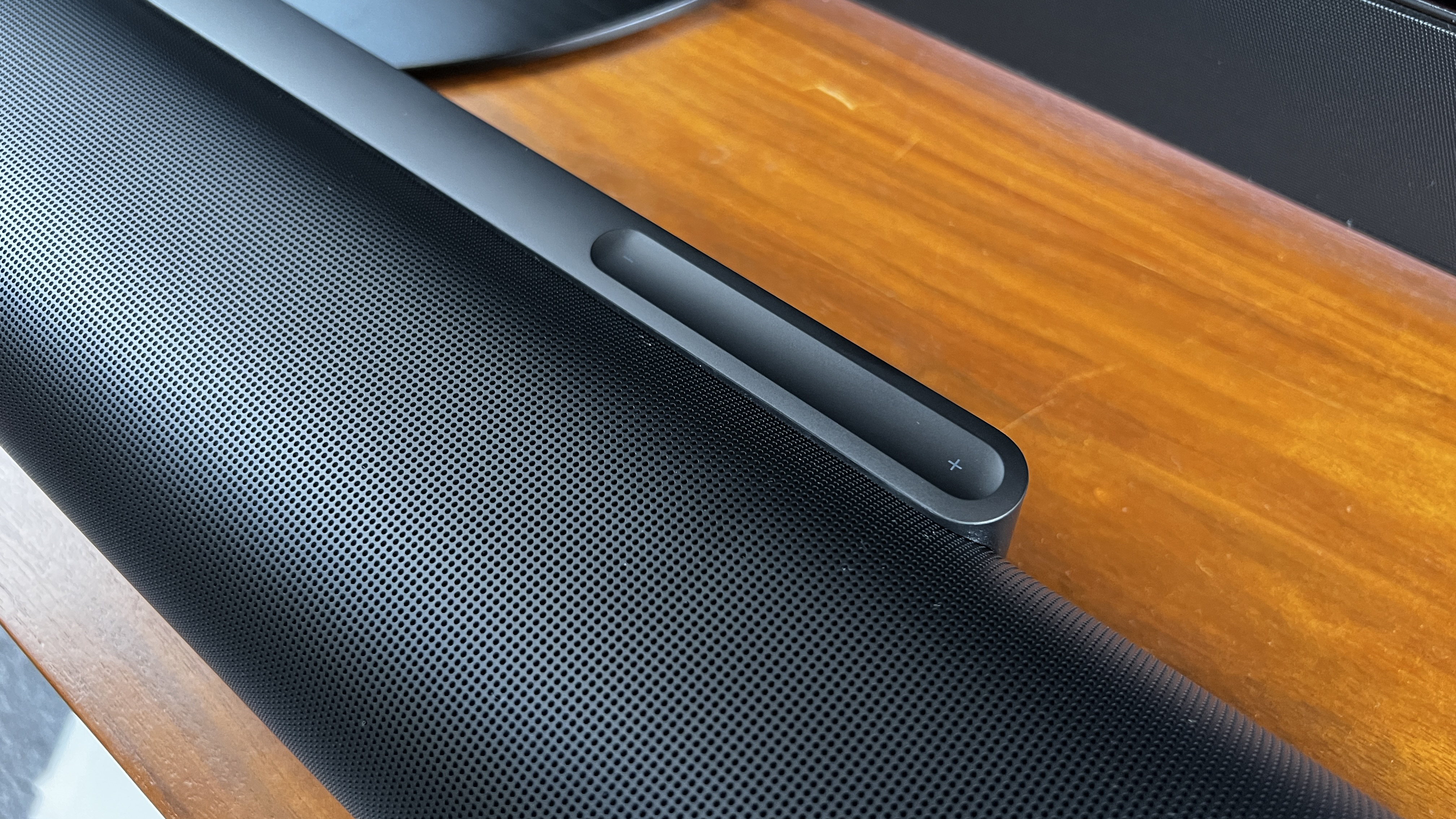
Sonos Arc Ultra review: Design
- Very well made and subtle
- Some key buttons hidden at the back
- Shorter but wider than original Arc
The Sonos Arc Ultra is 18% smaller by volume than the original Sonos Arc, according to Sonos, and this manifests in it being less tall (which is very welcome) and less deep (also welcome for those with chunky TV stands, though it’s still somewhat deep because it has a chunky bar across the back). However, it’s actually wider than the Sonos Arc. It’s still good for TVs of 55 inches and up, though, and the shorter height can make a real difference with some TVs.
It comes in black and white, and the overall look is very simple and classy. A hard, curved grille covers the entire thing, and it’s good at just disappearing into the room, which is what most people will want. The new design seems to pick up fingerprints worse than the old one, so be warned if you’re fastidious and have handsy kids.
The button for activating Bluetooth pairing mode is on the back, which is inconvenient for a soundbar, especially if it’s wall-mounted. You can pair from the Sonos app instead, but it would be better still if the Bluetooth button was on top, for maximum flexibility – especially since the button layout here was redesigned anyway, including moving volume over to the right, for whatever reason. In the middle, you still have buttons to play/pause, and skip tracks.
The switch to kill the voice control mics is also on the back, and is turned on by default, so the privacy conscious should remember to hit this before getting it situated. Also on the back is an Ethernet port, and then the power and HDMI ports are on the sides of the bit port cutaway on the rear – just like the original Arc.
The Arc Ultra is wall-mountable and works on the same mounts as the original Arc, which is nice for upgraders – though some of the mount may be visible, due to the change in size.
- Design score: 4 / 5
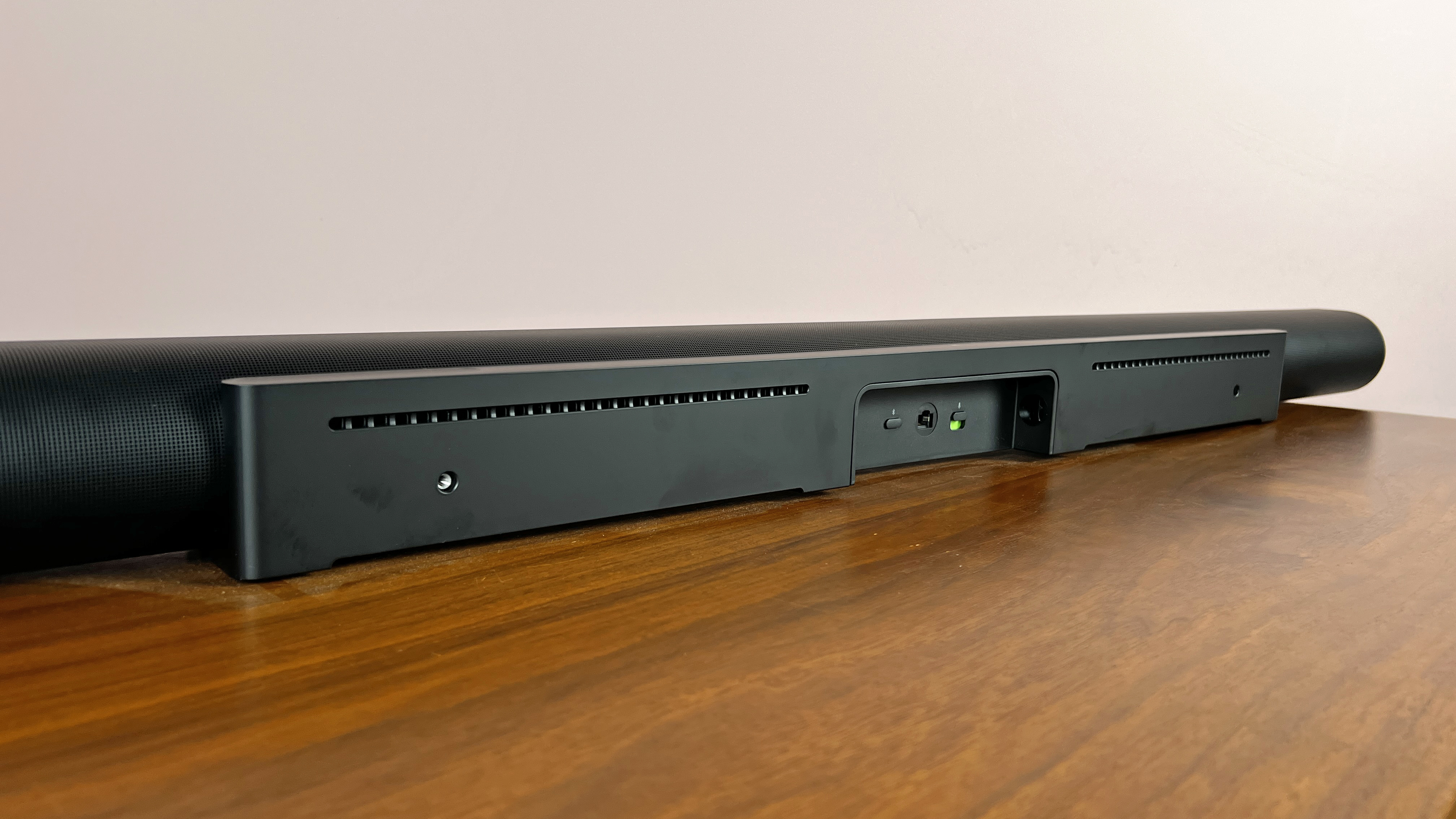
Sonos Arc Ultra review: Setup & usability
- Use Sonos app to get started
- TruePlay is now easier, and very useful
- Once connected to the TV, very little effort needed
If you have read or watched anything about recent Sonos releases, you will have seen strong opinions about the new Sonos app. We can’t post a video covering Sonos without a cascade of comments saying no one should ever buy Sonos again because of the state of the software. At launch, earlier in 2024, the app was missing a lot of features, and a lot of people had problems accessing or making changes to their systems.
At the time of writing this review, Sonos says that it has added 90% of the missing features back in, and is still committed to updates every two weeks to address bugs and performance while adding the remainder of the features.
I had no problems at all setting up the Arc Ultra at home through the app, making the settings adjustments I needed, and then adding/breaking multiple different surround setups while I tested different configurations of Sonos setups.
I did have trouble setting the surround system up in our office testing rooms, where the connection between the components would drop regularly – but this is pretty common on our office Wi-Fi outside of Sonos. I’ve had a problem getting Samsung’s soundbars to connect to register on the SmartThings app, and it can be difficult with smart home tech, so I don’t blame Sonos for this – but it’s only fair to note it if I’m going to dig into the experience. At home, on my normal mesh router setup, I had no problems at all.
The usability of Sonos’ soundbars continues to be a slightly mixed bag – I think if you designed an app for controlling a soundbar as its first priority, rather than playing music as its first priority, you probably wouldn’t bury settings like the Speech Enhancement that far down in the settings.
I’d love to see Sonos change how it approaches its Now Playing screen when you’re connected to HDMI, so it puts more emphasis on making settings available to you instead of a lack of artwork.
But setting it up was smooth, and most people won’t need to go back into the app, especially if you won’t connect other devices. As I mentioned, I found the speech clear enough without using the enhancement, and I didn’t think the EQ needed adjustment. TruePlay will be suggested as part of the setup too, and it worked with my remote (over HDMI-CEC, but infrared is also enabled by default) out of the box with no tinkering required.
- Setup & usability score: 4 / 5
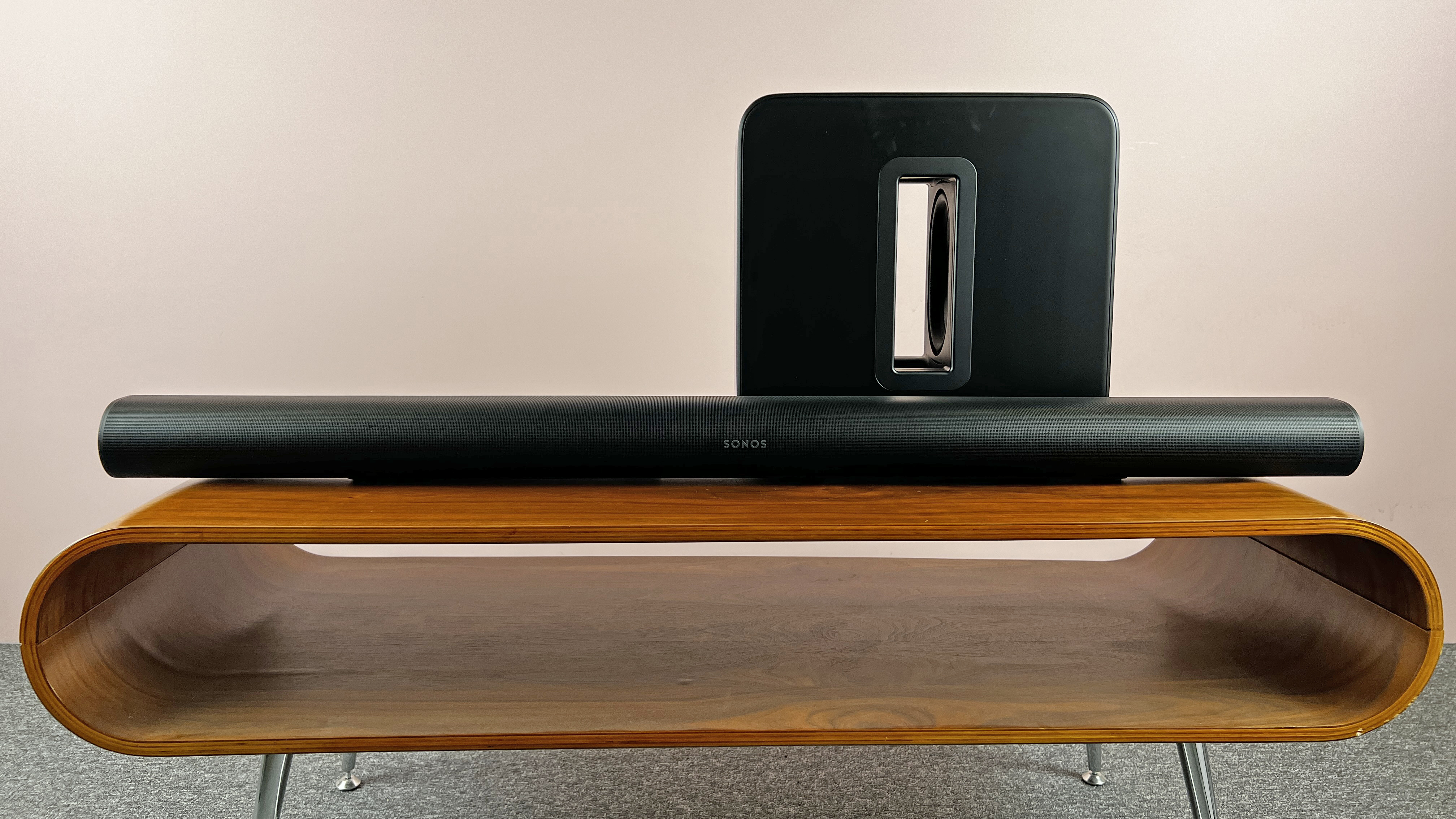
Sonos Arc Ultra review: Value
- Premium, but competitive price
- As good sound as you can get for the price
- Surround-ready products available around the same price
The Sonos Arc Ultra isn’t cheap, but if you want powerful, expansive, clear Dolby Atmos sound from a single inoffensively-designed soundbar, you can’t do better for the price – as long as you’re not tight on HDMI ports.
You can get a full surround setup for a similar price to this, but the core Sonos Arc Ultra is designed for people who don’t want to deal with having four boxes including a hefty subwoofer. And I think it’s the best, most cinematic single box you can add to your TV for the price, making it very strong value.
But as I say, if you’re already filling your HDMI ports, that value is harmed, because the Arc Ultra may create a new problem for you. For the price, it should really offer you the solution.
- Value score: 4 / 5
Should I buy the Sonos Arc Ultra?
| Section | Notes | Score |
| Features | Great for connectivity and useful options, except no HDMI passthrough or DTS. | 4 / 5 |
| Performance | Rich, full sound with excellent speech clarity and superb Dolby Atmos effects. | 5 / 5 |
| Design | Good-looking, but some buttons on the back would be better on top. | 4 / 5 |
| Setup & usability | Set up through the Sonos app, then it's plug and play – but some options are too hidden in the app. | 4 / 5 |
| Value | Best-in-class value for sound, but held back by the lack of HDMI passthrough. | 4 / 5 |
Buy it if...
You want the best sound from a single-unit soundbar
At this price, and without extra satellite speakers, nothing beats what the Sonos Arc Ultra can do.
You want clearer speech and Dolby Atmos cinematic effects
The Arc Ultra is a big step up over the Arc for dialogue, and boosts Dolby Atmos positioning skill at the same time.
You want Sonos' extra skills
Part of a multi-room music system? Check. The ability to add other speakers in the future to improve the sound? Check. TruePlay room tuning? Sound check.
Don't buy it if...
You're short on HDMI ports
No HDMI passthrough really could be a dealbreaker.
You want the best value sound and could have more than one box
The Sonos Arc Ultra is very good value for a one-box system, but if you can live with more hardware, you can get bigger sound for the price.
You're a home theater purist about DTS
Sonos' continued lack of DTS support will irk those those with physical media in DTS:X.
Sonos Arc Ultra review: Also consider
Sony Bravia Theater Bar 8
We didn't rave about this soundbar overall in our Sony Bravia Theater Bar 8 review, but it's cheaper than the Sonos Arc Ultra and offers 4K 120Hz HDMI passthrough, so it might be the most practical option for some people – or its more expensive sibling, the Sony Bravia Theater Bar 9 is the beefier-sounding option, but is pricier than the Sonos.
Sonos Beam 2
Want to go even more compact and have Sonos' options for expansion? The Beam 2 delivers surprisingly full sound for such a compact soundbar, and supports Dolby Atmos, but not with anything like the effectiveness of the Arc Ultra. But it's half the price, so swings and roundabouts – definitely read our Sonos Beam 2 review if you want to know more.
Samsung HW-Q990D
Look, if you can find this full Dolby Atmos surround system for close to the Sonos Arc Ultra's price, know that it will give you a truly mind-blowing Dolby Atmos home theater experience – as long as you can live with four boxes instead of one. We gave it five stars in our Samsung HW-Q990D review.
How I tested the Sonos Arc Ultra
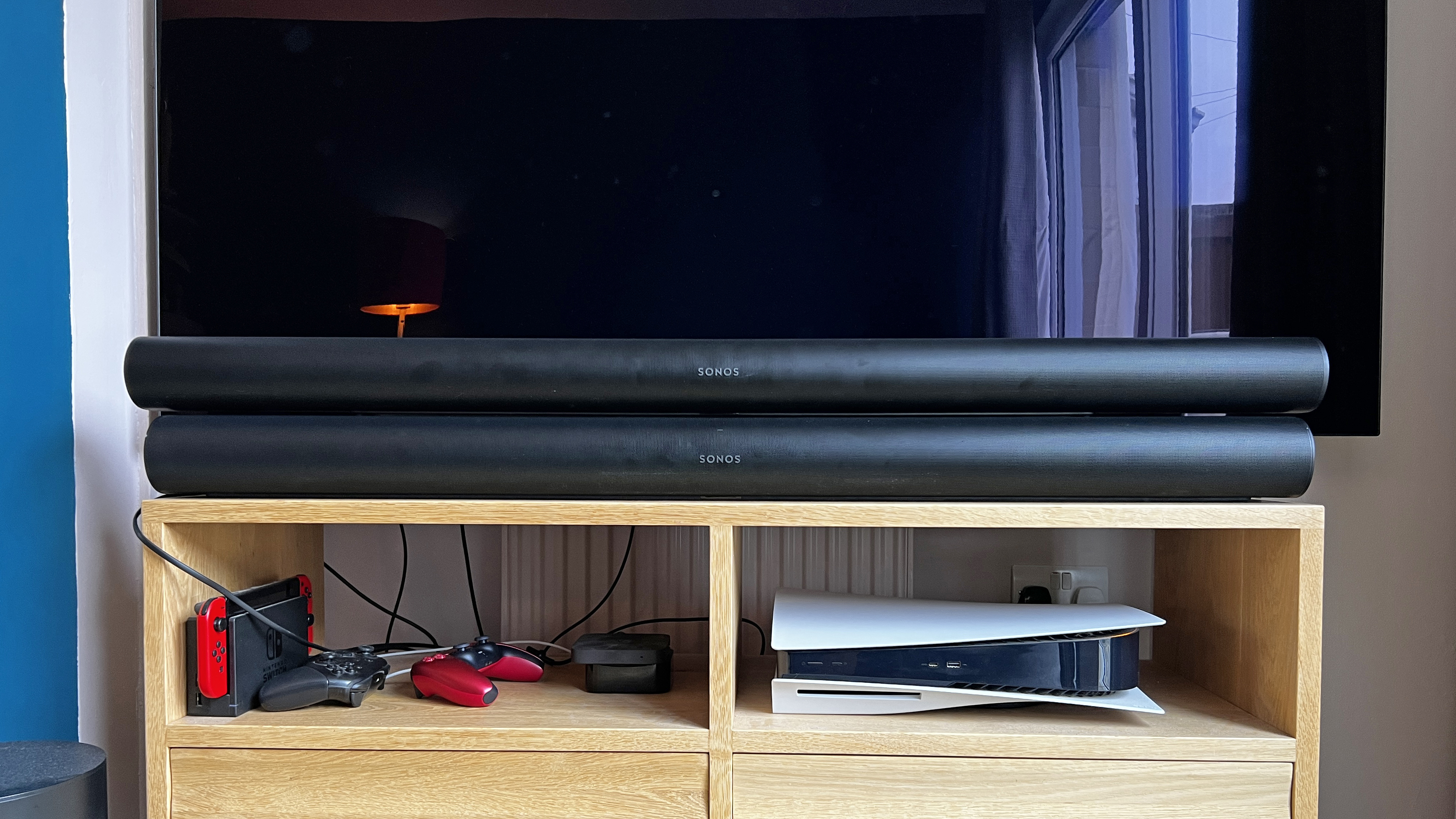
- Tested over a week
- Tested at home, in my usual setup
- Tested with Sonos surround configurations
For the crucial portion of this review, I used the Sonos Arc Ultra at home, in the same setup where I usually use the original Sonos Arc, so I had a good point of direct comparison. I directly compared the sound of the two bars to gauge the difference, but mostly I just used the Sonos Arc Ultra for my normal viewing, which included 4K Blu-rays and streaming. I listened in both lossless quality and compressed, as well as in Dolby Atmos, regular 5.1 surround sound, and in stereo.
As mentioned above, I tested the Sonos Arc Ultra on its own mainly, but also tried it with the Sub 4, and then with the Sub 4 and different Sonos rear speaker options.
I also tested a Sonos surround setup for a short time compared to the Samsung HW-Q990C in TechRadar's TV testing rooms. On our corporate Wi-Fi systems, I had connections problems that meant I couldn't do longer-term comparisons; at home, I use a Google Nest Home mesh Wi-Fi system and had no problems with the Sonos app or network connectivity.
- First reviewed: November 2024
- Read more about how we test

Matt is TechRadar's Managing Editor for Entertainment, meaning he's in charge of persuading our team of writers and reviewers to watch the latest TV shows and movies on gorgeous TVs and listen to fantastic speakers and headphones. It's a tough task, as you can imagine. Matt has over a decade of experience in tech publishing, and previously ran the TV & audio coverage for our colleagues at T3.com, and before that he edited T3 magazine. During his career, he's also contributed to places as varied as Creative Bloq, PC Gamer, PetsRadar, MacLife, and Edge. TV and movie nerdism is his speciality, and he goes to the cinema three times a week. He's always happy to explain the virtues of Dolby Vision over a drink, but he might need to use props, like he's explaining the offside rule.
